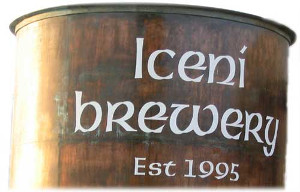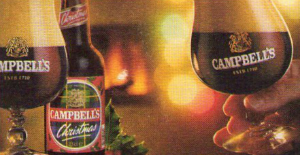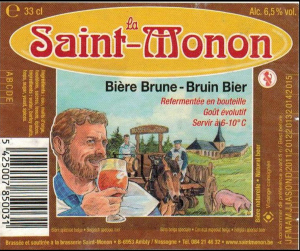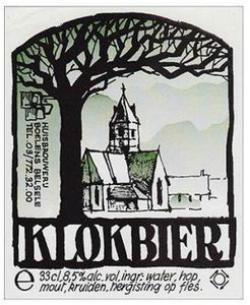They say… 
Best beer and travel writing award 2015, 2011 -- British Guild of Beer Writers Awards
Accredited Beer Sommelier
Writer of "Probably the best book about beer in London" - Londonist
"A necessity if you're a beer geek travelling to London town" - Beer Advocate
"A joy to read" - Roger Protz
"Very authoritative" - Tim Webb.
"One of the top beer writers in the UK" - Mark Dredge.
"A beer guru" - Popbitch.

|
 Brouwerij Maximiliaan, Amsterdam ABV: 6.5%
Origin: Amsterdam, Noord-Holland, Netherlands
Date: 16 April 2001
Another review from the archive written for the pioneering Oxford Bottled Beer Database (OBBD). I’ve left it uncorrected — so please read it in that historical spirit.
The Dutch beer scene has changed hugely since the first small crop of microbreweries in the 1980s and 1990s. Among these pioneers was Amsterdam’s Maximiliaan brewpub in Kloveniersburgwaal, which opened in 1992 in a heritage building on part of the site of the Bethany monastery or Bethaniënklooster on the city’s Oudezijd or Old Side. Its name referenced the fact that Holy Roman Emperor Maximilian I was also ruler of the Burgundian Netherlands in the late 15th century.
Despite some success, Maximiliaan closed not long after I wrote this review, in 2002, unable to afford a rent hike by the building’s owners, the not-for-profit heritage management foundation Stadsherstel Amsterdam. Thankfully the site wasn’t lost to brewing: the owners of the Beiaard specialist beer pub chain took on the business including the brewhouse and reopened it in 2004 under the name De Bekeerde Suster, or ‘converted sister’, a reference to the former religious community on the site. It’s still open today though the current Meibock uses a different recipe.
This is a strong spring beer from one of Amsterdam’s two micros, the Maximiliaan brewpub in the heart of the red light district. I didn’t sample it on home territory, however, but in Café Belgique, a tiny but welcome retreat hidden away within spitting distance of the madness of Damplein, which prides itself on supporting local independents as well as the Belgian imports suggested by its name.
The beer is a fine golden colour with a beautiful thick head and an aromatic hoppy aroma with a hint of lime and a lychee-like spiciness that suggests Alsatian Gewürztraminer wine. The palate is firmly malty with a creamy texture; then assertive bitter hops emerge, mixing with aromatic fruity hints. Further hops develop in the finish, but
soon soften to pineapples and cream. A serious beer with a sense of fun and a great way to welcome the spring.
 Salopian Brewery ABV: 4.7%
Origin: Shrewsbury, Shropshire, England
Website: www.salopianbrewery.co.uk
Date: 16 April 2001
Another review from the archive written for the pioneering Oxford Bottled Beer Database (OBBD). I’ve left it uncorrected — so please read it in that historical spirit.
Salopian is something of a survivor, reinventing itself several times since being founded by Martin Barry as Barry’s Brewery in a brewpub in the Snowdonian village of Gellilydan in 1992. Known for a while as the Snowdonia Brewery, it became Salopian when Martin relocated to Shrewsbury in 1995. Unusually for a British micro of the time, during this period and as referenced below it concentrated on bottled beers in unusual styles for outlets like Oddbins and Safeway, a strategy which in retrospect seems way ahead of its time.
At the time I wrote this review, the bottling activity was tailing off — as mentioned below, this beer might even have been contract-brewed at Brakspear — and Salopian became much more of a conventional British micro, brewing cask beers in traditional styles largely for the local market. There were several changes of ownership, with Martin leaving in 2004, but also fairly consistent expansion. The current phase began in 2008 when a new sales manager, Jake Douglas, spotted a trend and helped guide the brewery in a more hop-forward direction, with beers like Darwin’s Origin and Oracle.
This strategy has triggered further expansion and in 2014 Salopian moved to a bigger site outside Shrewsbury in Hadnall. The range is now very different and Gingersnap has long since disappeared.
In the late 1990s, this Shrewsbury-based brewery became a mainstay of British off-licence chain Oddbins’ forays into fine beer, with an imaginative bottle-conditioned range that gleefully mixed British tradition with a taste for wheat, fruits and spices inspired by continental models. Oddbins’ involvement apparently saved the brewery but then the retailer seemed to lose some of its enthusiasm for beer and Salopian slipped from its lists.
Having snapped up and enjoyed every Salopian bottle I’d encountered in my local Oddbins, I was pleased to see the brewer still making a showing at specialist retailer Bottles, though according to the current Good Beer Guide its bottled product is now brewed at Brakspear in Henley.
Gingersnap is typical of the brewery’s eclectic verve: a wheat beer flavoured with root ginger. The basic beer is more in the German style, brewed with malted rather than unmalted wheat, and is a deep reddish-copper colour with a reassuringly Germanic firm rocky head. It is, however, only slightly cloudy, and probably would have been even less so if I’d noticed the label’s instruction to pour British-style, without the sediment, before I’d sloshed it into the glass.
The aroma is dominated by ginger, with some hops, and the ginger continues in the mouth, but never overwhelms what turns out to be a beer with a complex, wheaty fruit character that remains crisply dry, aromatic and slightly herbal. In the finish the ginger proves beautifully warming, and the beer lingers with bitter-hop flavours and some spicy, zesty fruit. A thoroughly delicious and successful experiment that should be much more widely available.
 ABV: 4.4% ABV: 4.4%
Origin: Ickburgh, Norfolk, England
Website: http://icenibrewery.co.uk
Date: 26 March 2001
Another review from the archive written for the pioneering Oxford Bottled Beer Database (OBBD). I’ve left it uncorrected — so please read it in that historical spirit. Iceni is still around, now one of the longest-surviving 1990s microbreweries, though Norvic Ale was retired a long time ago.
This Norfolk micro is well-known for a commitment to bottle conditioning and a flair for unusual and experimental brews. Norvic Ale adds mustard to the list of oddities the more adventurous brewers have been using to perk up their malt and hops in recent years: the rationale is to pay tribute to the city of Norwich, home of Colman’s world famous mustard factories, and the name is the name of that city in its earlier Danish form.
There is no indication of how the spice is added: presumably it goes into the boil as seeds. Its presence is not immediatly obvious: the dark golden beer pours with a nice foamy head and the fresh scented aroma is lightly flowery.
The flavour develops well, at first clean and slightly creamy but always dry, then with more tangy tastes emerging, including, arguably, mustard and aromatic lychee-like fruit. A lengthy bitter development finishes the beer, rounding out to a citric tang. Pleasant, without being especially remarkable.
 Liefmans Jan van Gent ABV: 5.5%
Origin: Oudenaarde, Oost-Vlaanderen, Vlaanderen
Website: www.liefmans.be
First published: 26 March 2001
Another review from the archive written for the pioneering Oxford Bottled Beer Database (OBBD). I’ve left it uncorrected — so please read it in that historical spirit.
Liefmans owner Riva went bankrupt in 2007, and the brewery is now owned by the Duvel-Moortgat group. The new owners have understandably concentrated mainly on raising the profile of its celebrated brown ale, and Jan van Gent didn’t survive the upheavals, perhaps because it’s too close to other beers in D-M’s extensive portfolio.
Jan van Gent, incidentally, is the Dutch name of Plantagenet nobleman and military leader John of Gaunt, Duke of Lancaster (1340-99). He’s an appropriate namesake for a beer with both Flemish and English influences as he was born in Gent: ‘Gaunt’ is an archaic anglicised rendering of the city’s French name Gand. But gent is also ‘gannet’ or ‘gander’, and Jan-van-Gent is the Dutch common name for the seabird Morus bassanus, known in English as the Northern Gannet. It’s this bird that’s depicted on the label.
A newish line from Liefmans of Oudenaarde, East Flanders, now a subsidiary of Riva. It’s quite unlike the distinctive brown ales for which the brewery is justly famous, and a little disappointing.
A pale ale shading to blond, it is nicely fresh and bottle conditioned, slightly creamy and phenolic, but otherwise a very unprovoking combination of malt palate and tangy hops. Maybe I had a bad bottle – near the end of its declared shelf life – but I was left wondering why they didn’t just stick to brown ale.
 AB InBev Campbell’s Christmas Ale ABV: 8.3%
Origin: Leuven, Vlaams-Brabant, Vlaanderen
Date: 26 March 2001
Another review from the archive written for the pioneering Oxford Bottled Beer Database (OBBD). I’ve left it uncorrected — so please read it in that historical spirit.
Campbell, Hope & King’s Argyle Brewery in Edinburgh’s Cowgate was founded in 1710 or before, and when it was closed by Whitbread in 1971, it was reported as being the oldest brewery in Scotland. Interbrew, one of the predecessors of today’s world’s biggest brewer, Anheuser-Busch InBev, acquired the brand through its long association with Whitbread, the brewing interests of which it bought outright in 2001. Interbrew seems to have discontinued this particular brand in the mid-2000s.
The Gordons-branded ‘Scotch’ ales, referenced below, are no longer brewed in Edinburgh for export, as their former home, McEwan’s Fountain Brewery, was closed by Scottish Courage (now Heineken) in 2005. Instead they’re brewed in Belgium at John Martin’s brewery at Genval, Brabant-Wallonie.
One of a number of products that satisfy the Belgian predilection for strong, malty ales in broadly the Scottish 90/- or wee heavy style. This quirk of Belgian taste, particularly pronounced in winter, allegedly dates from World War I, when Scottish regiments were stationed in the country. Some brews in this style are made in Scotland for export, often in stronger versions than are generally available in the UK, but this is one of a number that are now brewed locally.
It’s a product of Interbrew’s vast Den Hoorn brewery in Leuven, but, as proclaimed on the label, is brewed ‘under the supervision of Whitbread plc, London’, an arrangement that long predates Interbrew’s takeover of the British megabrewer: presumably Campbells was a Scottish brewery that was long ago taken over and closed by Whitbread, and certainly the brand is no longer familiar in the UK domestic market.
The beer, which is not bottle conditioned but still very lively and was already past its best before date when consumed, is a very dark ruby with a notably rich aroma featuring glacé cherries, marzipan, cake and leather. The palate is also very full with cake and marzipan and burnt dried fruit, but also a cherryish sourness and a warming whisky-like whiff of alcohol.
A smoky, slightly chocolatey bitterness emerges in a rich finish, with petally notes developing as the beer settles. Given all this, my rating may seem ungenerous but there’s something missing here: for all its richness, the beer seems strangely bland, especially when compared to genuinely Scottish examples like Gordons Highland Scotch (brewed in Edinburgh by Scotco/Kronenbourg. Nonetheless, worth lingering over on a winter evening.
 Prignon Fantôme La Dalmatienne ABV: 8%
Origin: Soy (Erezée), Luxembourg, Wallonie
Website: www.fantome.be
First published: 26 March 2001
Another review from the archive written for the pioneering Oxford Bottled Beer Database (OBBD). I’ve left it uncorrected — so please read it in that historical spirit. Like all products from this brewery, availability and consistency can be erratic, and a dark version has been more familiar in recent years.
Another interesting beer from an innovative micro in Belgian Luxembourg, from a range stocked at Bottles in east London. The brewery’s flagship product is the difficult-to-categorise Fantôme: for background notes, see my review of that beer.
Here they seem to have set themselves the difficult task of brewing a bone-dry beer to a high gravity, and boy, have they succeeded. The contents of the champagne-style bottle are a delicate blond, and the bottle-conditioned beer pours lively with a good head, forewarning of its hoppiness from the start with its intense hop aroma that also includes other herbal hints, like savory and sage.
The palate, apart from being very slightly phenolic and a little yeasty, is utterly, unforgivingly and astonishingly dry, all 8% of it without a shred of sweet malt, and I suspect that there’s another bitter herb in there as well as hops. The beer finishes with an overwhelming grapefruit bitterness that lingers long way back in the throat. This is a very different bitterness to that found in, say, hoppy beers from the US, much more austere and less floral in character.
I must admit it was too intense for me, and arguably overbalanced – I took a very long time to finish the bottle – but if you enjoy bitter spirits like Jägermeister you would probably appreciate it more. The brewery’s trademark jolly ghost on the label is overwhelmed by dalmatian-dog style black spots, but I’m still trying to puzzle out the significance of the name. Any ideas?
 Good for improving your eyesight, better to spot those rare beers. ABV: 4.4%
Origin: Huddersfield, Kirklees, Yorkshire, England
First published: 26 March 2001
Another review from the archive written for the pioneering Oxford Bottled Beer Database (OBBD). I’ve left it uncorrected — so please read it in that historical spirit. Kitchen went into receivership later in 2001, perhaps not surprisingly given the beers sounded so unappetising no matter what they tasted like (the turnip and nutmeg beers referred to below were dubbed Tormented Turnip and Mystic Nutmeg). The clear glass bottles didn’t help either.
This British micro, in Huddersfield, Yorkshire, was founded by a former chef keen to experiment with ingredients more normally found in a kitchen: other brews feature turnip and nutmeg. The beers, including this one, picked up at the Pitfield Beer Shop, come in clear glass bottles, not an ideal form of packaging for a fine beer as it offers little protection from light and heat, but in this case it is presumably to reassure customers that the contents at least looks beer-like and doesn’t resemble carrot juice or vegetable soup.
There is no explanation, either, as to how the additional ingredients are used – with carrots, which contain some sugars, I would hazard a guess that they go into the mash to up the level of fermentables. There’s a suspicious whiff of gimmickry about all this, so it’s interesting to see how the beer measures up: not badly, as it turns out, though you’d be hard pressed to spot the healthy Vitamin A-laden root vegetable in the finished product, except perhaps for a very faint carroty hint in the aroma and a toffeeishness that might just about resemble caramelised carrots or carrot cake.
Otherwise this is a lively amber brew with a smooth but not generous head, announcing its bottle conditioning with a thick sediment clearly visible through the glass. The aroma, apart from the carroty notes, is sharp and hoppy, the texture slightly oily, and the palate well-balanced, with toffeeish malt soon offset by hoppy bitterness that persists in a sharp finish. It’s pleasant and refreshing, if not terribly complex, and you wonder how much contribution the carrots actually make, other than to the labelling and promotion.
 Saint-Monon La Saint-Monon Brune ABV: 7.5%
Origin: Ambly (Nassogne), Luxembourg, Wallonie
Website: www.saintmonon.be
First published: 19 February 2001
Another review from the archive written for the pioneering Oxford Bottled Beer Database (OBBD). I’ve left it uncorrected — so please read it in that historical spirit.
Brasserie Saint-Monon is still in operation and this beer is still very much part of its range. It’s actually on a farm in the geographical region known as the Famenne, not the Ardennes though close by, and right by the boundary with Namur province. It was founded by homebrewer Peter Jacob in 1996, which might be why Peter Crombecq hadn’t caught up with it by the time I wrote this piece.
I know little about this brewery except that it’s in wooded country in the Ardennes, in the Belgian province of Luxembourg – it’s not even listed on the internet version of Peter Crombecq’s Benelux Biergids. I dug out the dusty champagne-style bottle from a corner of Bottles beer shop in east London.
The label sports a rustic illustration but no ‘Best Before’ date: instead, the bottling date is indicated, along with a statement guaranteeing flavour development for two years, and since this example was bottled in February 1999, it should have been just at its peak.
Popping the cork gives off a winey, woody aroma with a touch of vanilla and a pastilly sweetness. The head is nice and smooth, rapidly diminishing but with lingering lace. The palate is soft and beautifully integrated, full of malt and red fruit (raspberries, blackcurrants), with a slight sourness, and again, a pastille-like aromatic sweetness with liquorice, dandelion and burdock and brown sugar.
The hops are clear but soft and rounded, envelopingly perfumed and herbal rather than full-on bitter, another sign of good bottle age. The finish is very long, with wood, sourness, liquorice and the herbal hop flavours lingering delightfully. A very fine bottle of beer.
 Boelens Klokbier (Tripel Klok) ABV: 8.5%
Origin: Belsele, Oost-Vlaanderen, Flanders
Website: www.brouwerijboelens.be
First published: 12 February 2001
Another review from the archive written for the pioneering Oxford Bottled Beer Database (OBBD). I’ve left it uncorrected — so please read it in that historical spirit.
I got the significance of the name badly wrong, forgetting that klok in Dutch can also mean ‘bell’. There’s a story that the inhabitants of Belsele once gave a visiting tinker all their gold and silver on the promise that he could mend their church bell, at which point he simply upped and left with the loot, never to be seen again. The locals were thereafter known as klokkenlappers or ‘bell menders’.
The original Boelens brewery closed in 1915 but was revived in 1993 as a microbrewery by Kris Boelens, a descendant of the original owning family. Klokbier is still around but it’s now labelled Triplel Klok and has a dubbel stablemate.
A beer from a small brewery in Belsele, East Flanders, halfway between Gent and Antwerpen, known for its Bieken honey beer. I haven’t worked out the significance of the name, which means simply ‘Clock-beer’, but the attractive hand-drawn label depicts a small village church, and the bottle-conditioned beer is distantly monastic in style.
It’s sweet and honeyish, though in this case honey isn’t listed on the ingredients, though it is flavoured with herbs. The beer pours peachy and cloudy, with an impressively generous sediment, and gives off an intensely fragrant, honeyed, herbal aroma with perhaps a hint of woodruff. On the palate it is lively and orangey, with a lip-coating candied sweetness, tangy drying notes and perhaps a hint of cinnamon.
Hops develop on the tongue and continue to dry out the throat on the swallow, leaving a mainly dry finish with persistent candied notes and a late touch of marzipan. Enjoyably fragrant and stimulating, if just a little too sweet.
 Van Eecke Kapittel Pater ABV: 6% and 9%
Origin: Watou, West-Vlaanderen, Flanders
Website: www.leroybreweries.be
First published: 12 and19 February 2001
Two more reviews from the archive written for the pioneering Oxford Bottled Beer Database (OBBD). I’ve left them uncorrected — so please read them in that historical spirit.
The Van Eecke brewery in Watou is still around, though after many years of close family links with Leroy brewery, also known as Het Sas, in nearby Boezinge, early in 2017 it formally became part of the same group under the name Leroy Breweries. The facilities in Boezinge are bigger and better-equipped so some former Van Eecke brands are partly or wholly brewed there, including the famous Poperings Hommelbier mentioned below. But I suspect the abbey beer range is still being made at Watou. The beers are now labelled simply as Kapittel, without the definite article ‘Het’.
The group sources hops locally and the beers now carry the ‘Belgsiche Hop’ kitemark indicating at least 50% of the hops used are Belgian-grown. I still think it’s quite likely that the hops include Goldings, though the variety is also grown locally so may not be from Kent. But when I say ‘hoppy’, note that standards on this have changed a little since 2001! Note also that these beers, though in the generic abbey style, are not one of the officially accredited Erkend Belgische Abdijbieren as they’re not associated with any particular religious institution, despite the appreciative monks depicted on the packaging.
Van Eecke, in Watou, is one of a cluster of small breweries around Poperinge, in the heart of West Flanders hop country, a connection commemorated in this brewery’s best-known product, the blond and marvellously hoppy Poperings Hommelbier. Pater, in contrast, is an abbey double, a style not normally noted for its hoppiness, but hops make their presence felt all the same.
The beer is a burgundy brown, with a big chocolate, red wine and varnish aroma and a nice thick head. It’s softish in the mouth, well-conditioned (in the bottle) with some sparkle on the tongue, a winey, juicy malt palate and a hoppy edge to the taste right from the start. Some sweetness develops, but recedes again in a complex finish with distinct hoppy dryness and earthy notes that suggest Kent Goldings, only a channel-crossing from home.
The hop character distinguishes what is otherwise a competent, if a little rough-edged, beer that could be a little better-integrated, but certainly has something to say for itself in a fairly crowded market.
Prior doesn’t fit into the conventional categories of double and triple. Like Pater it’s uncharacteristically hoppy for the style, and goes one further, being a dry and notably strong dark ale. It’s burgundy-coloured, with a smooth and long-lasting head, and a rich aroma with hops to the fore, backed by plenty of dark figginess. The condition is very lively and the palate mainly malty with some fruit and chocolate, quickly developing a pronounced dry bitterness with a touch of peach: there is something in the rich malt/fruit character that reminds me of the blue-capped 8% ale from the nearby Westvleteren Trappist monastery.
The finish is very, very drying, with plenty of bitter chocolate and hops and a quinine-like touch developing. It’s a surprise to find such a strong and dark beer that tastes so dry and austere.
|
Cask  This pioneering new book explains what makes cask beer so special, and explores its past, present and future. Order now from CAMRA Books. Read more here. This pioneering new book explains what makes cask beer so special, and explores its past, present and future. Order now from CAMRA Books. Read more here.
London’s Best Beer  The fully updated 3rd edition of my essential award-winning guide to London’s vibrant beer scene is available now from CAMRA Books. Read more here. The fully updated 3rd edition of my essential award-winning guide to London’s vibrant beer scene is available now from CAMRA Books. Read more here.
|














